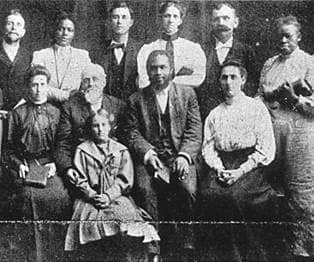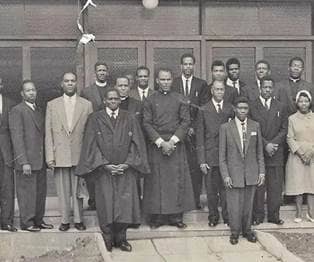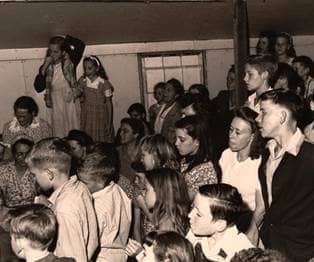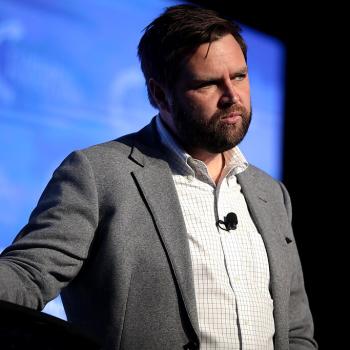- Trending:
- Forgiveness
- |
- Resurrection
- |
- Joy
- |
- Afterlife
- |
- Trump
Pentecostal History
Early Developments
Though there are many reported cases of people speaking in tongues at various times in revival-like settings during the time of the Holiness movement of the 19th century, two competing times and places still capture the imagination of Pentecostals and vie for title of the source of the Pentecostal movement. As such, when discussing early developments, it is important to mention Charles F. Parham's Bethel Bible College in Topeka, Kansas and William J. Seymour's Azusa Street Mission in Los Angeles. These two locations, and the men that headed these ministries, are emblematic of a movement that often defies description, and whose fluidity makes it impossible to full satisfy everyone's desire for a single place of origin.
In his search for understanding Spirit baptism, Parham spent two years on the road visiting two of the major proto-Pentecostal leaders of the day, Frank Sandford in Maine and Alexander Dowie in Illinois. When Agnes Ozment spoke in tongues on New Year's Day 1901, Charles Parham believed he had received the answer to his question of how to meld Spirit baptism with a defining experience. Spirit baptism was followed by speaking in tongues, as evidenced by Ozment's experience. Linking the experience with the theology became Parham's theological legacy. By 1910, however, Parham's own quest for power and his personal issues lead to the unraveling of his ministry. Parham died in relative obscurity in 1929 never having recovered from allegations of homosexuality, an affinity for racist theology, and an obsession with eschatology.
The Azusa Street Mission's chief contribution to the early development of Pentecostalism was its incredible spread beyond the southern California area and Seymour's attempt to offer an alternative vision to the larger Christian world of a church community where different races, ethnicities, and genders worshiped together. From 1906 to 1909, hundreds of people, including some of the most prominent early leaders of the Pentecostal movement, traveled to Los Angeles in hopes of receiving the baptism of the Holy Spirit. Those who found what they were looking for usually went back to where they came from and began their own Pentecostal churches.
William Durham, innovator of the "Finished-Work" theology (defining the baptism of the Holy Spirit as the finished work after salvation, bypassing the need for a second work of sanctification), received the baptism of the Spirit at Azusa Street, went back to Chicago, and almost immediately began spreading Pentecostalism throughout the Swedish, Norwegian, and Persian communities in Chicago; many of them, in turn, returned to their homelands and began Pentecostal missions.
G.B. Cashwell, a Holiness preacher from the south, went to Los Angeles and returned back to the south in 1907, preaching the baptism of the Holy Spirit. Cashwell's influence would be felt in the formation of his own Pentecostal Holiness denomination as well as his influence on others such as A.J. Tomlinson, who would later lead the Church of God (Cleveland, Tennessee) to accept Pentecostalism. A number of women also came out of Azusa Street who would take leadership positions.
In keeping with Seymour's desire to place women in church leadership, he gave permission to Florence Crawford to begin a church in Portland, Oregon. In a curious side episode, Seymour's decision to marry Jeannie E. Moore in 1908 allegedly elicited a rather negative reaction from his church secretary, Clara Lum. Lum promptly left Azusa Street and joined Crawford in Portland, taking the mailing list for Seymour's magazine, The Apostolic Faith, with her. Crawford at first did not want anything to do with the purloined list, but eventually relented and began building her ministry from the list. Crawford's church, The Apostolic Faith Church, would not be the last Pentecostal church built on less than stellar circumstances.
Among other notable persons at Azusa Street were Rosa and Abundio Lopez, who began a ministry among the Mexican population in Los Angeles and, subsequently, in their native Mexico. There is also evidence that Armenians and Russians took their newfound faith back to their homelands as missionaries. Aside from the growth of the movement beyond Los Angeles, one more leader of note needs to be included here. Charles H. Mason went as a skeptic to Azusa Street in 1907, and upon receiving the baptism of the Holy Spirit, began to organize the Church of God in Christ in Memphis; this denomination is the largest African American Pentecostal denomination in the United States.
One of the most influential Pentecostal leaders of the early 20th century was "Sister" Aimee Semple McPherson (1890-1944), who almost single-handedly spread the Pentecostal message of divine healing throughout the United States and around the world. She founded the International Church of the Foursquare Gospel, one of the largest Pentecostal denominations, and its college in Los Angeles, which trained numerous Pentecostal leaders. McPherson was known both within church circles and as a public persona, partly because of her itinerant preaching and partly because of the well-publicized and occasionally scandalous events of her life.
As diffuse as the early Pentecostal movement was, the desire to maintain its spiritual effervescence meant for many an aversion to organizing around denominations, since this was thought to be one sure way to "quench the Spirit." Despite the early Pentecostal desire not to organize, they, like others who are drawn to charismatic leadership, gradually formed organizational structures. Ironically enough, then, Pentecostals founded denominations-as early as 1907-and fellowships intended to add structure to their often disorganized ministry and missions efforts. With this organization, though, came the inevitable divisions over doctrine, practice, and personality.
Schisms and Sects
Because Pentecostalism is a movement that builds on experience and revelation rather than creeds or confessions, schisms have been an intrinsic part of the larger community. Pentecostalism has been subject to many denominational splits. While remaining unified in the essential theology of salvation, many divisions have stemmed from different understandings of the relationship between conversion, sanctification, and the baptism of the Holy Spirit.
Pentecostals with a Holiness background generally believed that sanctification was second defining work of grace in their lives, and that it happened after conversion. Pentecostals from non-Holiness backgrounds such as Baptist William H. Durham believed that sanctification was a progressive process, and that it occurred at conversion. In 1910, at a Chicago Pentecostal meeting, Durham preached on the idea that sanctification and conversion were synonymous based on the "finished work" of Jesus' death and resurrection. Therefore, one did not have to wait for a second work of sanctification in order to ask for and receive Spirit baptism.
In 1911, the controversy flared when Durham's teaching became common knowledge among Pentecostals. On a trip to Los Angeles, Durham was kept from preaching at one Pentecostal church (Upper Room), and as he was going to preach at Seymour's Azusa Street Mission, Durham found that he had been locked out of the church. The controversy continued for another three years when in 1914, with the organizing of the first denominations to form out of Azusa Street, the Assemblies of God chose to be associated with the "Finished Work" theology, while most Southern Holiness-influenced Pentecostals (the Church of God, Cleveland, Tennessee; the Pentecostal Holiness Church; and the Church of God in Christ), chose to remain part of the group that retained sanctification as a second work of grace.
Other splits have occurred over issues of polity or were due to issues over the perceived liberalization of Holiness standards. One of the oldest Pentecostal denominations, the Church of God in Cleveland, Tennessee (1886) split into several smaller Churches of God, the largest being the Church of God Prophecy. All of those splits occurred over leadership issues. One of the largest African American Oneness denomination, the Pentecostal Assemblies of the World (1918), has split into several smaller bodies, such as the Church of Our Lord Jesus Christ, (1924), over leadership and holiness issues. One church split-Congregational Holiness Church's split from the International Pentecostal Holiness Church in 1920-was over the use of medicine in addition to divine healing.
The most significant schism was that of the Oneness split from the Trinitarian branch. During a 1913 camp meeting in Los Angeles, where noted healing evangelist Maria Woodworth-Etter was the main attraction, another well-known minister, Canadian Robert T. McAlister received a revelation about baptism. McAlister said that the baptismal formula found in Acts 2:38 ("in the name of Jesus Christ") was the preferred method of baptism, not the traditional Christian formula ("in the name of the Father, Son, and Holy Spirit"). A group of ministers resonated with McAlister's words and accepted them as prophetic words; they soon began to preach this alternative baptismal formula and urged people to be re-baptized. An Australian minister, Frank Ewart, took McAlister's prophetic words a couple of steps further. Not only was the baptismal formula wrong, but also the entire idea of the Trinity was erroneous. God was Jesus; the rest of the names of God-Father, Son, and Holy Spirit-were titles and did not denote different people in the Godhead. So many Pentecostals sought to be re-baptized that organizing these varied Oneness groups soon proved to be an urgent need.
Between 1913 and 1914 the largest Pentecostal denomination at the time, the Assemblies of God (founded in 1913 in Hot Springs, Arkansas), lost nearly a quarter of its ministers when it decided to become part of the Oneness movement. After an intense battle, the Assemblies of God codified its doctrine in the "Statement of Fundamental Truths" in 1916, and Oneness was deemed theology outside the mainstream of Pentecostalism. In 1918, Oneness adherents, needing to develop their own organization after effectively being ousted from Pentecostalism, founded the Pentecostal Assemblies of the World, headed by African American Garfield T. Haywood, in Indianapolis. Oneness is the largest schism to emerge from dozens of early splits and schisms that affected Pentecostalism's nascent years.
Further out on the periphery of Pentecostal schisms and splits were the snake-handling churches that flourished in the Appalachian areas of the U.S. These churches operated under the authority of the Church of God, Cleveland, Tennessee and the Church of God Prophecy until they were officially ostracized in the 1940s. One of the key figures of this movement was George Went Hensley. Hensley was a minister with the Church of God in Cleveland, Tennessee in the early 20th century. In response to intense times of prayer, he believed that he had received a revelation commanding him to "take up serpents" (a reference to Mark 16:18).
Though the practice of snake handling existed before Hensley, he popularized the practice by preaching it as a part of the full Pentecostal message. Upon being ostracized from the Church of God, Hensley founded the non-denominational Church of the God with Signs Following. Scholars such as Ralph Hood have posited that the lack of growth in these churches is not simply the danger one equates with snakes, but that the high risks associated with this movement simply do not offer enough tangible benefits (community, social networks, etc.) for people to make that risk. As such, after 100 years, there are only about 50-100 churches that practice snake handling, located mostly in the Appalachia region of the United States.
Another Pentecostal sect that arose from within the ranks of accepted Pentecostalism was the Word of Faith movement, made popular by such figures as Kenneth Hagin, Oral Roberts, Kenneth Copeland, and others. Hagin, in particular-a former Assemblies of God minister-is credited with popularizing the movement. Word of Faith teaching deviates from traditional Pentecostal teaching in its encouragement of a practice by which a person is promised that he or she will receive something by believing he or she already has it and speaking it into existence through "positive confession." This movement is partly influenced by the 19th-century New Thought movement that gave rise to Christian Science. E. W. Kenyon-an early 20th century Pentecostal healing evangelist, speaker, and author-drew heavily on New Thought and combined it with Pentecostal emphases on divine healing. Broader controversies include the Word of Faith movement's near wholesale adoption of the prosperity gospel, which teaches that God and humanity have a reciprocal relationship with each other, so material wealth is based on how much money is given back to God via the ministries' coffers.
Because the Word of Faith ministers have become so controversial, they have formed networks among themselves to mimic the organizational support that they do not receive from being affiliated with a denomination. Word of Faith teachers of various stripes dominate U.S religious television broadcasts, particularly southern California-based Trinity Broadcasting. Because of the movement's tremendous media savvy, they are one of the most dominant strains of global Pentecostalism.
Missions and Expansion
Petecostalism's focus as an eschatological missions movement has not changed that much from its inception in the early 20th century; its global breadth is staggering when one considered where it began. Within Pentecostalism's first twenty years, Azusa Street missionaries had developed churches in China, India, Japan, Egypt, Liberia, Angola, Brazil, and Mexico. It should be noted that in many of these places, Pentecostal-style revivals where spiritual experiences such as healing, prophecy, and tongues were the norm had already begun; there were noted revivals, independent of American Pentecostalism, in India (1905), Pyongyang, (1907), Oslo (1907), Chile (1909).
To return briefly to Azusa Street and its significance as a missions sending area, the accounts of people receiving the Spirit baptism there and promptly leaving the U.S. to spread the message globally is quite impressive, especially considering that many of those early missionaries were women who traveled alone to places such as China, India, and various countries in Africa and Latin America. There they often founded churches and orphanages, and were the de facto leaders of the Pentecostal movement's early foray as a world religion. By October 1906, thirty-eight missionaries had left the Azusa Street Mission to go overseas. Pentecostal missionaries were in fifty nations by 1908. John G. Lake began Pentecostal missions in South Africa. Juan Navarro (re-baptized in the name of Jesus in Los Angeles by Mexican Oneness pioneer Romanita Carbajal de Valenzuela), returned to Mexico and began to spread the Oneness-inspired Pentecostalism he was exposed to in Los Angeles, baptizing future leaders of the oldest Latino Pentecostal group, Apostolic Assemblies of Jesus Christ, in the name of Jesus. Lucy Farrow, a black Holiness preacher who had first invited Seymour to preach in Los Angeles, became a missionary to Liberia.
Other missions-sending centers for Pentecostalism included the Chicago area where Durham's church, the North Avenue Mission, became a place where Luigi Francescon and Gioacomo Lombardi, Italian immigrants who settled in Chicago, are credited with starting missions in Italy, Argentina, and Brazil. Gunnar Vingren and Daniel Berg left the midwest to start the Assemblies of God in Brazil. These missions trips helped refine one of the essential doctrines of Pentecostalism-xenoglossia. When missionaries realized that they were not able to speak the language of their host country, the Parham-inspired idea of xenoglossia waned in favor of today's present understanding that speaking in tongues is speaking in an unknown language.
The missions story of Africa and China are too complex to replay here, but it is worth noting that these are two areas where earlier Pentecostal-like revivals and movements helped usher in the American missionaries; Pentecostalism established deep roots and flourished after the end of colonialism. Some scholars have posited that Pentecostalism flourished in Africa not because American missionaries succeeded in destroying the African popular religious worldview, but because Pentecostalism made sense out of their worldview. Pentecostalism assumes that there is a supernatural connection to God who acts through dreams, visions, healing, and other divine interventions. Unlike some other Christian missions that discredited African supernaturalism, Pentecostalism took it seriously.
In China, after the initial American Pentecostal missions efforts of the Assemblies of God and Church of God, Cleveland, Tennessee, their impact waned. It was largely absent from the Shandong Revival of the 1930s-a major movement that helped spread Pentecostalism throughout China through the work of indigenous groups like the Spiritual Gifts Society. This revival is particularly interesting since in addition to traditional spiritual gifts being reported, there were "raptures" of people who claimed to have ascended to heaven, tasted food, and had beatific visions of Jesus. Of note here is the conflating of such "ascensions" with spirit possession prevalent in the popular religions of China.
These Chinese Pentecostal movements sprung up while other American missions organizations spent their time developing institutions such as schools and medical clinics. In the midst of the political chaos in China during the 1930s, American Pentecostals focused on an eschatological message that read the signs of chaos as millennial harbingers of the coming end. Their experience in China, along with other international events, encouraged American Pentecostals to move away from a postmillennial view of bringing the Kingdom of God on earth, to a more pessimistic view that hunger, poverty, disease, and natural disasters all pointed toward a culmination of the end of time and the return of Jesus.
Today, regional adaptations are largely based on the existing social and cultural conditions surrounding Pentecostalism. In the United States, the more Holiness-oriented groups tend to be in the midwest and south. In some contexts, the desire to be separate from what some have viewed as the liberalizing tendencies of urban centers has contributed to a more conservative, piety-centered faith. Denominations such as the Assemblies of God and International Church of the Foursquare Gospel (founded in 1924) have historically found more stability and cultural similarities with suburban and rural areas, opening churches in those areas far more frequently than in the urban centers. Foursquare, for example, has seven churches in the Chicago area, and another fifty in the rest of Illinois.
Church of God historian Mickey Crews surmises that the Pentecostal affinity for rural and suburban areas stems from their own insecurity. Crews believed that his denomination, for example, found solace in starting churches in places that they understood-rural and largely white. Feeling that they would not be accepted in cities and among diverse populations, Pentecostals internalized these inferior feelings and have continued their insularity from their early days through today. Today, however, there are many representations of Pentecostalism in urban settings; those churches are overwhelmingly either African American or Latino.
Exploration and Conquest
Throughout its history, Pentecostalism has remained rather consistent in terms of missions. While some ideas about cultural contextualization and local autonomy have reformed what was once a very paternalistic activity, Pentecostals historically have viewed terms such as "conquest," "empire," and "persecution" as spiritual terms. Conquering the world for Jesus was and is the goal of all mission activity. Creating God's kingdom on earth through conversion is thought to be an acceptable form of "empire building." Persecution for the sake of preaching the gospel is considered to be inevitable, therefore it is not something to be afraid of.
For many early Pentecostals, conquering the world for Jesus, along with religious conversion, meant converting them from what were viewed as deficient cultural traits. What has changed to some degree is the extent to which Pentecostal missionaries lay the blame for their persecution on the "pagan" religions that share the country with them. The language of "saving" a people from the "darkness" of unbelief still exists, but it has become nuanced language supporting the exclusivity of Pentecostalism, without the coarse references to other religions.
For example, Native Americans were once viewed by most Pentecostal denominations as an exotic "home mission" (missions targeting racial and ethnic minorities in the U.S.). Their rituals and belief system were described as "pagan." Missionaries to Native Americans were not expected to be versed in the culture or language of the particular tribe; in fact, missionaries to Native Americans were often picked from other minority groups, assuming that Latinos, for example, would have something in common with Native Americans and therefore be able to communicate the Gospel to them more effectively.
Some of the first missionaries to the Aleut natives of Alaska were Mexican American converts sent from Los Angeles in the 1950s. Today, among Foursquare Native American churches, there is growing acceptance and promotion of the "contextualization" method of missions, where the idea is not to subvert the existing cultural and ritual practices but to use them for evangelistic purposes. For example, burning of sage and smudging of ashes-often in full native dress-are part of nearly all Foursquare native services. This is not to suggest that contextualization is now the norm among Pentecostal missions; there is still fierce resistance to this method in the largest denomination, the Assemblies of God, which views contextualization as little more than an accepted form of syncretism.
One of the prime movers of the sustained missions movements over the last half-century has been the imperative of fulfilling what many interpret as the "Great Commission" (Matthew 28:19-20) to convert the nations. Coupled with a renewed sense that the prophecy from Joel 2:28-29 is being fulfilled, Pentecostal missionaries since the 1970s have begun to fan out to nations that have not traditionally been Christian, especially the so-called 10/40 window-a term that refers to a band of countries between 10 and 40 degrees north of the equator, stretching from the middle east, northern Africa, India, and China.
Evangelical missions organizations, such as "Voice of the Martyrs" (VOM), serve as information hubs for missionaries in this area. Operating much like Amnesty International, VOM reports on the continued harassment and imprisonment of Christian missionaries around the world. This continued persecution of missionaries sustains the martyrology of Pentecostals, who today are imprisoned in countries across that 10/40 line. They also sometimes face expulsion, such as in Belarus, because of a tightening of the rules governing religious minorities in the former Soviet Union. Most notable here are the nationalities of the missionaries, many of whom are Korean, Chinese, and indigenous groups who are spreading the Pentecostal message outside of their own cultural and language groups. The "reverse missions" phenomenon has brought about a radical shift in the identity of missionaries. While missions were dominated by white westerners for the better part of the 19th and 20th centuries, in less than fifty years, Koreans have become the second largest missions-sending group in the world (after Americans).
Modern Age
The formative years of American Pentecostalism (1906-1940) were marked by a time of organizing the movement into various denominations that stabilized leadership, codified doctrine, and provided infrastructure to missions, education, and evangelism. Soon thereafter, as a response to the perceived loss of spiritual vibrancy, independent evangelists began advocating for a renewal of the church, outside the established denominations, which they called human institutions that quenched the Spirit. Leaders to come out of this anti-denominational phase included Kenneth Hagin and Oral Roberts, who through theological and technological innovations such as televangelism brought Pentecostal practice to a mass audience.
The 1940s saw the formation of the Pentecostal Fellowship of North America (PFNA), which was an umbrella group for cooperation and fellowship between Pentecostal denominations in the United States. The PFNA held diverse Pentecostal groups together for many years until it was disbanded in 1994 because of its exclusion of African Americans. Leaders of the Church of God in Christ (COGIC) established its replacement, the Pentecostal/Charismatic Churches of North America (PCCNA), which is a multi-racial association of over 30 denominations.
The charismatic movement is one of the most significant and wide-reaching expressions of Pentecostal influence. The charismatic movement began as a spiritual renewal movement in the 1960s, chiefly in mainline Protestant, Catholic, and to a lesser degree, Orthodox churches. Not wanting to change their theology or leave their denominations, charismatic groups flourished amidst bemused and suspicious denominational leaders, many of whom wondered what this meant aside from some temporary emotional flourishes.
Father Dennis Bennett (1917-1991), an Episcopal priest, announced to his congregation in Van Nuys, California in 1960 that he has spoken in tongues. Bennett took his ministry to the northwest shortly thereafter and was an advocate for the charismatic renewal within the Episcopal church and among other mainline Protestant churches until his death in 1991.
Vying for the title of the "founder" of the charismatic movement was Harald Bredesen (1918-2006), a Lutheran pastor who received Spirit baptism in 1946. As a pastor in the 1950s, Bredesen shared knowledge of his charismatic experience with Pat Robertson (1930-) and was the person who introduced Robertson to speaking in tongues. Bredesen continued his work in the Lutheran church's Alliance of Renewal Churches in 1962.
The most sustained presence of the charismatic movement has been in the Roman Catholic Church, where, beginning in 1967 in a number of Catholic colleges and universities, laity began seeking charismatic experiences. The charismatic renewal was most prominent on the campus of the University of Notre Dame and Duquesne University. This movement received a vote of confidence from Cardinal Leo Jozef Suenens (1904-1986). Suenens was dispatched to the U.S. in 1972 to see for himself if this charismatic renewal was acceptable to the Vatican. Impressed by what he saw, Suenens supported the U.S. renewal, advocating that the gifts of the Spirit had not ceased with the ancient Church, but were in use today to renew the Church. From 1974 to 1986, Suenens wrote or co-wrote six documents on the charismatic renewal that still serve as theological guides for the Catholic Charismatic renewal.
As a way to harness the energy of the charismatic movement to the 1960s youth culture, a few enterprising pastors with Pentecostal roots began ministries to young people, emphasizing the work of the Holy Spirit as well as conversion. One such pastor was Chuck Smith, a former Foursquare pastor, who began ministry to the surfer culture in southern California in 1965, and shortly thereafter formed Calvary Chapel. Calvary Chapel and its later spin-off, the Vineyard under John Wimber, were charismatic denominations that formed outside the classical Pentecostal denominational structures. They were evangelical in theology and charismatic in practice and worship, without the Pentecostal dogmatic insistence on speaking in tongues as the initial evidence that a person had been baptized with the Holy Spirit.
The next flourish to Pentecostalism would be drawn from the post-war boom of young people, many of whom were predisposed against the Holiness-inspired piety of their parents, pastors, and churches. The Jesus movement was distinctly charismatic, had roots in the Foursquare denomination, and radically re-drew the picture of Jesus. It focused on Jesus as a friend and required that one have a personal relationship with Jesus. It taught that the gifts of the Spirit were not necessarily a part of a ordered pattern, but that God worked however God worked; whether or not one spoke in tongues as the initial evidence of Spirit baptism became secondary. By the 1970s, nearly every Christian denomination had evidenced some type of charismatic activity. The cultural and social contexts of these movements helped determine what their focus would be. For some, healing was preeminent; for others, deliverance ministries, focused almost exclusively on exorcism, became their foci.
Today's global Pentecostalism is, in significant ways, renewing the face of what some have seen as an increasingly stagnant Christianity. In the U.S., as in other parts of the globe, Pentecostalism is growing, but usually within specific racial and ethnic groups. The reasons for this growth are numerous, but it is clear that Pentecostalism's adaptability, its ability to be theologically innovative in a fluid religious marketplace, make it more readily acceptable than non-charismatic evangelicalism, or mainline Protestantism.
According to some sociologists, Pentecostalism's global growth will only be equaled by the growth of Catholicism. Although this is speculative, what is certain is that if current trends continue Pentecostalism, which in its early years was characterized as a distinctly American, white, midwestern, and southern phenomenon will no longer carry that connotation, but will be marked by its multiracial and multiethnic congregations. Already nearly 75% of all Pentecostals live in the developing (or "two-thirds") world. At the same time, Pentecostalism in the U.S. accounts for about 10% of all Christians.
Globally, Pentecostals and charismatics combine to make up 450 million of the roughly 2 billion Christians worldwide, the largest Christian group outside the Roman Catholic Church. The greatest growth has been in three areas: Latin America, Asia, and Africa. Whereas at the beginning of the 20th century Pentecostals accounted for a tiny fraction of Christians in these areas, now, according to an influential survey conducted by the Pew Research Center, the numbers for Pentecostalism in the developing world are approaching 1 billion members.
The numbers for certain countries in Latin America, once an overwhelmingly Catholic region of the world, are equally impressive. In terms of Protestantism in these countries, Pentecostalism is now approaching parity with established mainline denominations. In Brazil, 49% of Christian respondents were Pentecostal/charismatic; in Guatemala, 60% of respondents were. In Kenya, 56% of respondents in Kenya were Pentecostal/charismatics; in South Africa, 34% were. In Asia, 44% of respondents in the Philippines were Pentecostal/charismatics; in contrast, in India only 5% were.
These global Pentecostals share a number of characteristics in common with their U.S. counterparts, and they are helping to shift practice from tongues to healing. Remarkably, a similarity in both U.S and global Pentecostals is that 40% of respondents responded that they rarely or never pray in tongues as a part of their devotional practices.
If one were looking for ties that bind the U.S and global Pentecostal movements together, it would be their similar stances on moral issues (homosexuality and abortion) as well as their belief in some form of prosperity gospel (God's blessing is necessary for me to be rich, or being rich is my natural condition if I am faithful). The differences between global and American Pentecostalism lie in a variety of practices, theological innovations, and the shifting cultural demographics in the United States.








